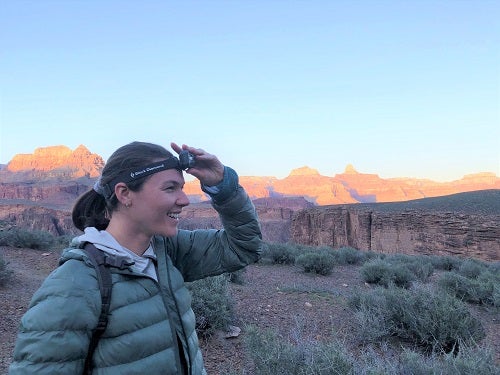
Boise State University MS Raptor Biology student Kirsten Fuller defended her thesis, “The effect of habitat, survey protocol, and methodology on Mexican Spotted Owl (Strix occidentalis lucida) occupancy and detection in a remote canyon environment” on the afternoon of October 21, 2022. Fuller’s advisor is Dr. Jen Cruz (Boise State University Raptor Research Center, Biological Sciences), and her committee included Dr. Jesse Barber (Biological Sciences) and Dr. Jim Belthoff (Raptor Research Center, Biological Sciences).
ABSTRACT
Assessing changes to species occupancy at breeding sites can help determine whether those sites are continuing to support the species over time. Additionally, evaluating the efficiency and value of survey techniques used to determine occupancy can help streamline data collection. This is important for the management of threatened and endangered species, especially in a world broadly impacted by anthropogenic pressures. Grand Canyon National Park in Arizona is one of the most highly visited parks in the United States, with over 6 million visitors a year. Backcountry hiking and camping are popular activities at the park, and many highly visited trails and campgrounds overlap established territories of a threatened species, Mexican Spotted Owl. I aim to assess long-term occupancy and detection of Mexican Spotted Owls at the park, as well as evaluate two monitoring techniques.
I ran a multi-season occupancy model with call-back survey data collected from 2001 to 2021, with habitat characteristics and visitor statistics as predictors to assess long-term occupancy and detection probabilities. I also ran a single-season occupancy model with data collected by autonomous recording units (ARUS) using habitat and protocol-related predictor variables. Visitor presence had no effect on owl occupancy, which remained stable over the 20-year study period. Owl occupancy was linked to PACs with a higher proportion of mixed shrubland habitat and Supai formation, while PACs with more pinyon-juniper woodland habitat and Redwall Limestone were linked with decreased occupancy. ARUs were found to be useful for detecting owls early in the breeding season, prior to the official call-back survey period, but became less effective later in the season. Overall, ARUs are a useful tool for supplementing traditional call-back surveys, particularly at PACs with extremely limited access, but should not be expected to replace traditional methods.